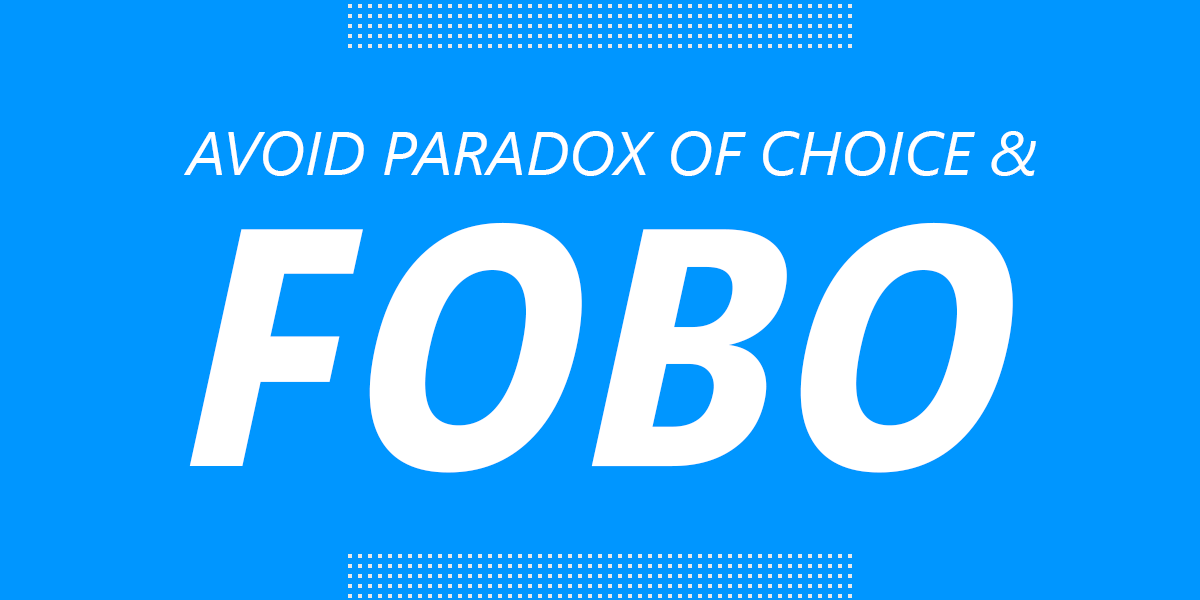How to Make Faster Decisions to Avoid Paradox of Choice and FOBO

Back in the day a consumer would go to a retail store, choose between different product options and buy the one that seemed ‘worth the money’. All of that included not only technical specifications but also a lot of personal preferences that allowed a consumer to pick one product over the other. All that changed with the mainstreaming of online shopping. Now, consumers are no longer limited to a handful of choices, since someone in Washington, D.C. can order a product from not only the United States but as far as China! This leads to fear of better options, as people endlessly deliberate on buying something that costs less than their morning coffee. Let us show you how to avoid the paradox of choice and FOBO for make faster decisions.
FOBO and FOMO
FOMO or Fear of Missing Out is known as one of the most common reasons why people check their social media accounts and smartphones throughout the day. Even when there is no meaningful update or a message in their inbox. A more troublesome trend that has now emerged globally is FOBO or Fear of Better Options, similar to Paradox of Choice.
People can endlessly waste time online to look for the best deals possible, hoping to save money, being unable to truly differentiate between hundreds of misleading deals. For example, someone might take one deal over the other as one is 50% off on two items and the other is buy one get one free. However, both products might be evenly priced, making both deals the same. In this case, the consumer might think that one of the two deals is better than the other, while in essence both products are offering the same price for two units. Similarly, people can endlessly end up wondering which PowerPoint theme to use for their presentation, suffering from paradox of choice.
What Does Paradox of Choice Mean?
Barry Schwartz, an American psychologist in his 2004 book titled ‘The Paradox of Choice – Why More Is Less’ argued that reducing the choice for consumers can help reduce their anxiety. This is in essence FOBO, as customers fear missing out on better options as their choices exponentially increase. This paradox of choice can be quite harmful for consumers, causing anxiety, waste of time and even sleepless nights shopping for the best deals. People can even get so immersed in these deals that it can begin to affect their personal life and even workplace performance.
What are Paradox of Choice Examples?
Before we discuss how to overcome the paradox of choice, let’s take a look at a few examples of the phenomenon.
Buyer’s Remorse
Did you ever feel guilty after buying a product, thinking that you missed out on a better option? This is called buyer’s remorse. Many times, people who suffer from buyer’s remorse might not have even missed out on a good deal. The way targeted online advertisement has begun profiling customers through buyer personas, we can safely assume they know things about us that even we don’t know about ourselves. Be it buying preferences, temptations that can allow us to unnecessarily make our wallets lighter and click-baits we should know better than to fall for!
Opportunity Cost
When buying products, we account for opportunity costs every day. Foregoing one product in favor of another or buying something for a family member by foregoing our own needs are all opportunity costs we make to manage our budget and use our finances according to what we have. This opportunity cost becomes complex when choices exponentially increase, causing paradox of choice.
Buying Decisions for Businesses
It’s not just a customer at a retail store which suffers from the paradox of choice, as many entrepreneurs can face the conundrum of choosing between a service best suited for their business. For example, does an entrepreneur opt for a fully automated or semi-automated customer complaint logging mechanism? And if so, what services should he/she integrate for the best customer care? The paradox of choice for entrepreneurs can make or break their business. The stakes are high, and it can be hard to know what gives the best value for money!
How to deal with Paradox of Choice
Paradox of choice is easier to overcome than you might think. Here are a few ways you can avoid it using a few simple life hacks.
1. Evaluate the Stakes
To avoid paradox of choice you must be able to determine if a decision is worth your extra time and energy. You can divide decisions in three ways, no stakes, low stakes and now stakes!
No Stakes: A no stake decision can be to decide which channel to see while flipping through dozens or even hundreds of them. You need to realize that this decision is a no stakes decision and does not require your extra time. So, you have to pick a choice and stick to it. It’s like deciding whether you want to have tea or coffee for breakfast, the choice has no real consequences.
Low Stakes: So, you’re buying shoes but are confused which one to buy. This is a low stakes decision. You can look at your needs, your budget and see what fits your preferences. Keep your list simple, compare a few products and eliminate choices one by one. Don’t go back to the eliminated option and you will have a final choice in no time.
High Stakes: These are decisions that can have a major impact on your life. For example, buying a house, investing a large sum of money in a business or taking a bank loan that you might not be able to pay back if things don’t go as planned are examples of high stakes that you need to account for. In such a case it is best to not only try to gather the best information related to your choices but also to consult trusted people who are experts or are experienced at the subject. You can even pick a group of people such as 3 or 5. Using an odd number will help you break a tie and find better options.
2. Set a Goal
Once you know the stakes, you can outline a goal. You might want to leave the deliberation for mainly decisions with low or high stakes. For example, when you set out to buy a smartphone, know your needs, understand your budget limitations and decide what might be the best option. For example, if you need faster processing and more space, you might see the phones within your budget ceiling that offer a better processor, RAM and space. When buying online or comparing products, use filters for price, RAM and processor and you will have a final choice soon enough.
3. Array the Options
If you have enough money to buy only one pair of shoes and your formal pair you use for office is worn out, there is no point buying joggers. You can buy them later and cater for the immediate need that will help you avoid embarrassment at the workplace.
4. Pick a Winner
If you’re buying an air conditioner, do you need one with an anti-bacterial filter, one which consumes less electricity or one which can help cool a large room quickly? Maybe you need all three and have the budget to buy it. In such a case, shortlisted models which fit these three and eliminate the ones with e.g. bad reviews, high price and shorter warranty time. You will have a final choice in no time!
Final Words
By classifying products in line with the stakes attached to them, setting goals, arraying and eliminating options and using simple comparisons, you will be able to pick a winner. The only thing left after that is committing to the final outcome. No one can truly force you to do that, you will have to overcome that bit of FOBO yourself. Commit to the best evaluated outcome and don’t look back!

